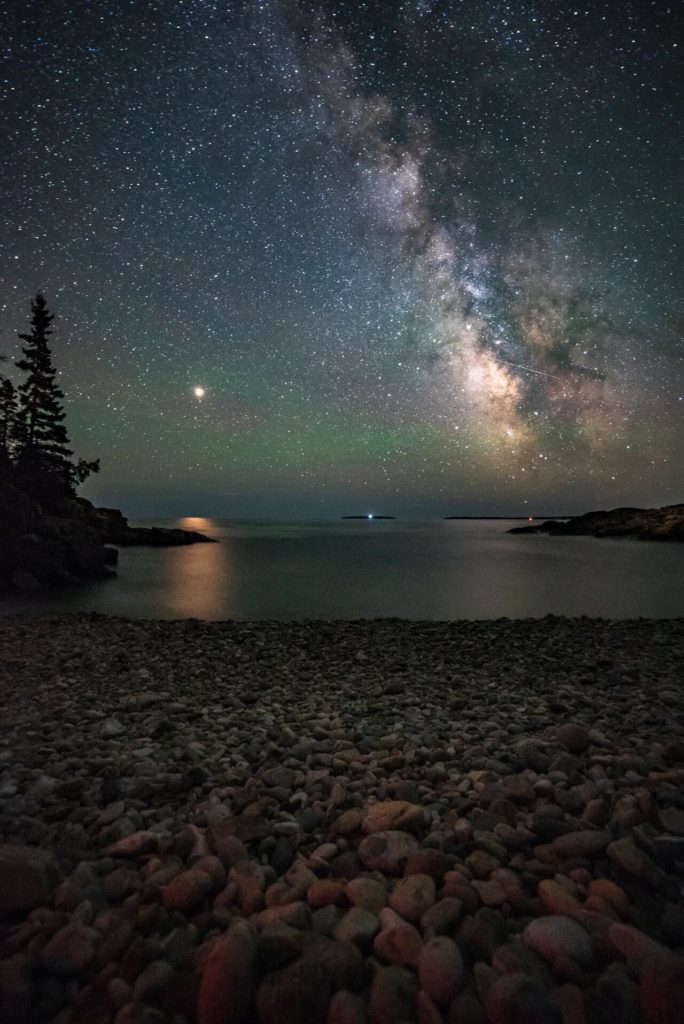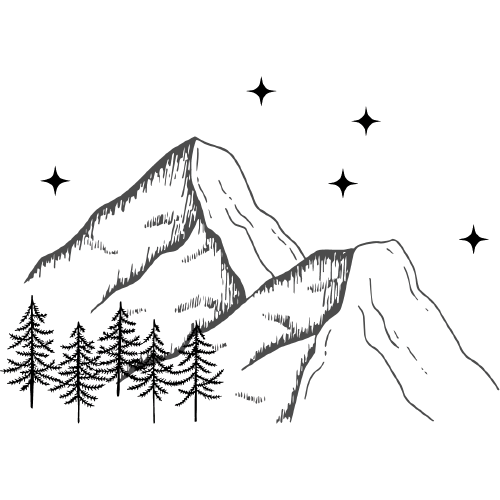Stargazing in Acadia National Park: Complete Guide for Beginners
Stargazing in Acadia National Park is a truly wonderful experience.
Acadia National Park is one of the largest areas of dark sky in the eastern United States. And with so much of the park bordered by the Atlantic Ocean, there are so many locations where you can look out towards the ocean away from any sources of light pollution.
It’s an activity that can’t be missed on any trip to Acadia National Park (as long as you have clear skies).
Here’s what you need to know about stargazing in Acadia National Park.
Want to watch the stars until the sun comes up? Check out these stunning sunrise hikes in Acadia National Park!

When to Go Stargazing in Acadia National Park
If you are planning your trip to Acadia National Park around stargazing, here are some factors to consider about timing.
The best time for stargazing in is around the new moon. If there’s a bright moon lighting up the night sky, it’ll be more challenging to see all of the stars above you. Make sure to look at a calendar with the moon phases when you’re choosing the dates for your trip.
If you REALLY want to center your trip to Acadia around stargazing, visit the park during the annual Acadia Night Sky Festival. This festival includes several days of educational activities to protect and enjoy Acadia’s night sky. The Acadia Night Sky Festival occurs in September every year (check the festival’s website for the specific dates each year).
Stargazing Programs in Acadia National Park
Acadia National Park is one of the many national parks that offers night sky programs.
These programs are a great way to get even more out of your experience stargazing in Acadia National Park.
During Acadia’s free, hour-long Night Sky Talks, a park ranger will share history and science of the night sky.
These Night Sky Talks are held at Sand Beach. Check for the dates and times of Night Sky Talks on the Acadia National Park program calendar.
Best Places in Acadia National Park for Stargazing
If you’d rather enjoy stargazing on your own or a stargazing program isn’t offered during your visit to Acadia, don’t worry! There are many great places around the park to check out the night sky.
Here are 5 of the best spots for stargazing in Acadia National Park. They are all on Mount Desert Island (the main section of the park), primarily on the east side of the island.
Jordan Pond
Many visitors come to Jordan Pond for a taste of the popovers at Jordan Pond House, but make sure to come back at night for stargazing.
Move around Jordan Pond to check out the night sky from various vantage points. For a great view of the Milky Way and other planets, head around the east side of the pond along Jordan Pond Path.
Sand Beach
Sand Beach is an excellent spot for stargazing in Acadia National Park.
There are two reasons in particular that Sand Beach is an ideal spot for stargazing. First, the beach is surrounded by Great Head and Otter Cliffs, which block light pollution from the nearby town of Bar Harbor. Second, the beach looks out over Newport Cove towards the southern part of the night sky.
On top of all this, Sand Beach is the only sandy beach in Acadia National Park. This makes it a great place to spread out a blanket and lie down as you stare up into the starry sky.
A bonus reason to come to Sand Beach at night: check out bioluminescent plankton lighting up in the water!
Note that although Sand Beach is open at night, camping and overnight parking are not allowed.
Ocean Path
The Ocean Path Trail runs along a 2.2-mile stretch of the southeast coast of Mount Desert Island. This means there are plenty of places along the trail to find a view of the night sky.
Ocean Path is a popular spot in Acadia National Park during the day, but all of the crowds will be gone by the time the stars come out.
The coastline here is rocky, so bring a chair or blankets to sit on so you have a comfortable place to sit. Be extra careful when moving around rocky surfaces and cliffs in the dark.
Seawall
Seawall is the only location recommended here that is on the “quiet side” of Mount Desert Island.
It’s a good place for stargazing in Acadia National Park for anyone who is staying at Seawall Campground or other campgrounds on the western side of the island.
Check out Seawall Picnic Area (across the street from Seawall Campground) on a starry night for a magical view of the stars twinkling over the Atlantic Ocean.
Cadillac Mountain
Cadillac Mountain is the highest point not just in Acadia National Park but along the entire Eastern Seaboard.
Up at 1,530 feet, you’ll have unobstructed panoramic views of the night sky.
Although there are no physical obstructions on the top of Cadillac Mountain, keep in mind that you may see some light pollution from Bar Harbor.
If you want to drive up Cadillac Mountain for stargazing, know that the road to the summit closes to traffic at 10pm each night. The road is closed entirely during the winter (typically until mid-April) and a vehicle reservation is required during peak visitation months (May through October). A vehicle reservation is not needed if you plan to hike or bike to the top.
The weather on Cadillac Mountain can be much different than it is at lower elevation. Bring extra blankets or layers and check the weather to make sure you’ll actually get a clear night up on the mountain.
Tips for Stargazing in Acadia National Park
- Wait one to two hours after sunset to start stargazing.
- The most light pollution on Mount Desert Island is near Bar Harbor and Southwest Harbor.
- Bring a blanket or chair to sit on and a headlamp with a red light feature to preserve your night vision.
- Download an app such as Stellarium to identify constellations and planets in the night sky.
- If you have a digital camera, check out photography tips from the National Park Service.
FAQs about Stargazing in Acadia National Park
- Can you see the Milky Way from Acadia National Park? Yes!
- Can you see the Aurora Borealis from Acadia National Park? Yes, Acadia is far enough north to see the northern lights, though the best time of year to see it is in the winter.
- Is Acadia an International Dark Sky Park? No, the International Dark-Sky Association has not designated Acadia National Park as a Dark Sky Place. But the park still has one of the darkest night skies on the east coast.
Need more help planning your trip to Acadia National Park? Check out these related articles:
- Best Camping In (And Near) Acadia National Park
- 6 Stunning Sunrise Hikes in Acadia National Park
- 4 Must-See Lakes at Acadia National Park (+10 More Ponds)
- How To Plan A National Park Trip: 7 Tips For A Perfect Visit
As always, enjoy the outdoors responsibly. Leave no trace on all of your adventures.
